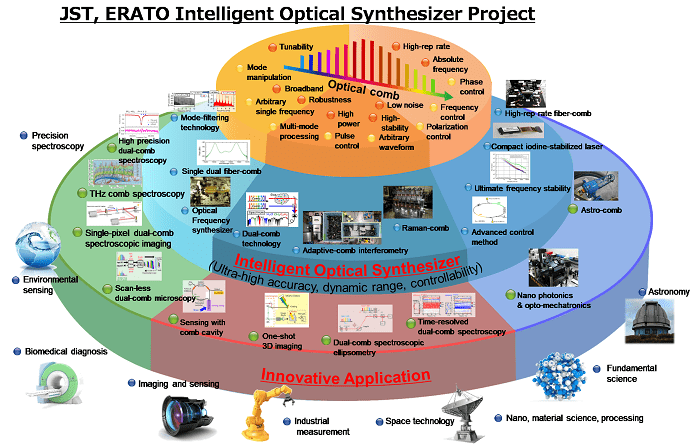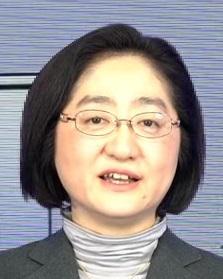March 2019 Issue
Research Highlights
JST-ERATO Intelligent Optical Synthesizer (IOS) Project
Optical technology has not been utilized to its full potential, although there is no doubt about its importance for applications in daily life and science and technology. By appropriate control of the unique properties of optical waves with high precision and wide dynamic range opens of the possibilities for innovative applications over a broad range of fields.
The main goal of the JST-ERATO Intelligent Optical Synthesizer (IOS) Project [1,2] is to develop optical technology for controlling properties of light waves based on advanced laser technology, referred to as "Optical Frequency Combs" (OFCs). Simply started, OFCs is composed of large numbers of equally spaced, optical frequency modes. This discovery was awarded the Nobel prize in physics in 2005 and has been known as the most precise "optical ruler" ever made by human-beings.
However, in spite of the attractive features of OFCs, there is a huge gap between technology available for producing light sources and real-world applications. To bridge the gap, there is high expectation of research on the development of technology to utilize the full properties of OFCs and for basic application technologies utilizing its unique features.
Kaoru Minoshima, the Research Director of the ERATO-IOS project and professor of the UEC, and her project team are developing a diverse range of fundamental technologies for controlling broad aspects of optical waves based on OFCs, such as in time, frequency, space, phase, polarization, coherence, as an "optical synthesizer", which is an analogy of musical instruments known as synthesizers. Moreover, the ERATO-IOS project team are utilizing the controllability of light for broad innovative applications, which are based on original and innovative applications of the full range of properties of OFCs, not only as previously reported precision frequency rulers, but as extremely accurate tools for multi-dimensional information conversion and control over a wide dynamic range.
The researchers have developed a wide variety of OFC sources exhibiting world-class performances for applications, such as the highest repetition rate low-noise Yb:fiber OFC that was stabilized without additional amplification [3], a fiber laser which emits highly coherent two OFCs ("dual-comb") simultaneously enabling high-precision, broadband and rapid spectroscopy with practical light source [4], and mode-filtering technique for high sensitive spectroscopy that can be applied for real-time environmental and medical sensing [5,6]. The team have also developed new spectroscopy techniques for direct and rapid characterization of the complex properties of a broad range of materials and devices with a wide dynamic range in time, frequency, and space domains [7,8]. An ultrafast three-dimensional imaging method was also developed, which is expected to be applied to rapid sensing of microscopic to large objects without losing its high accuracy [9,10]. The team has also developed a high-accuracy long distance measurement technique with automatic compensation for air turbulence by propagated light itself that is expected to play a major role in industry and big science. Notably, one of the OFCs developed in this project was installed in an astronomical observatory for future application for searching extrasolar planets.
The technologies being developed have opened up new and important applications of light, and there is the potential for many other applications covering a broad range of fields.

References
- http://www.jst.go.jp/erato/minoshima/en/index_e.html
- http://www.ru.uec.ac.jp/e-bulletin/feature/2014/research-an-optical-comb-for-medicine-environment-astronomy-and-other-applications.html
- Y. Ma, B. Xu, H. Ishii, F. Meng, Y. Nakajima, I. Matsushima, T.R. Schibli, Z. Zhang, K. Minoshima, Low-noise 750MHz spaced ytterbium fiber frequency combs, Optics Letters 43 (2018) 4136-4139.
- Y. Nakajima, Y. Hata, K. Minoshima, High-coherence ultra-broadband bidirectional dual-comb fiber laser, Opt. Express 27 (2019) 5931-5944.
- A. Nishiyama, S. Yoshida, T. Hariki, Y. Nakajima, K. Minoshima, Sensitivity improvement of dual-comb spectroscopy using mode-filtering technique, Opt. Express 25 (2017) 31730-31738.
- Y. Nakajima, A. Nishiyama, K. Minoshima, Mode-filtering technique based on all-fiber-based external cavity for fiber-based optical frequency comb, Opt. Express 26 (2018) 4656-4664.
- A. Asahara, A. Nishiyama, S. Yoshida, K.-i. Kondo, Y. Nakajima, K. Minoshima, Dual-comb spectroscopy for rapid characterization of complex optical properties of solids, Optics Letters 41 (2016) 4971-4974.
- A. Asahara, K. Minoshima, Development of ultrafast time-resolved dual-comb spectroscopy, APL Photonics 2 (2017) 041301.
- T. Kato, M. Uchida, K. Minoshima, No-scanning 3D measurement method using ultrafast dimensional conversion with a chirped optical frequency comb, Scientific Reports 7 (2017) 3670-3671-3678.
- E. Hase, T. Minamikawa, T. Mizuno, S. Miyamoto, R. Ichikawa, Y.-D. Hsieh, K. Shibuya, K. Sato, Y. Nakajima, A. Asahara, K. Minoshima, Y. Mizutani, T. Iwata, H. Yamamoto, T. Yasui, Scan-less confocal phase imaging based on dual-comb microscopy, Optica 5 (2018) 634-643.



